Nightlife by Angrymog
Introduction
Original SA post
Apologies for the image quality - I have no scanner, and the camera on my phone isn't up to much. I've done what I can to tidy things up a bit. Whilst I have a PDF, it's of one of the later editions and apart from the cover, the art's changed a lot.
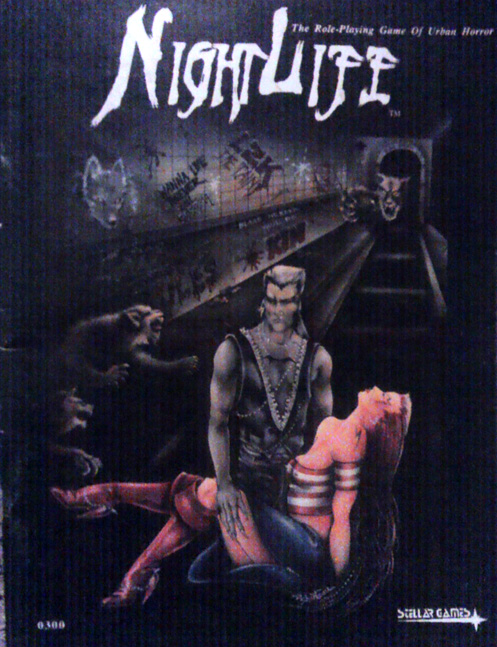
So eighties

Nightlife is a game of urban horror set in an alternate New York were trains have been replaced with werewolves. Subway rats have also been replaced with werewolves. It's also very cold.
Seriously though, it's splatterpunk urban horror and was published in 1990, a few months before Vampire. The book is 80 pages long and stapled. All illustrations apart from the cover are in black and white. It uses a two column layout with a readable font, and going by the ToC, the book is sensibly organised.
Introduction
The introduction gives us our first look at the internal art
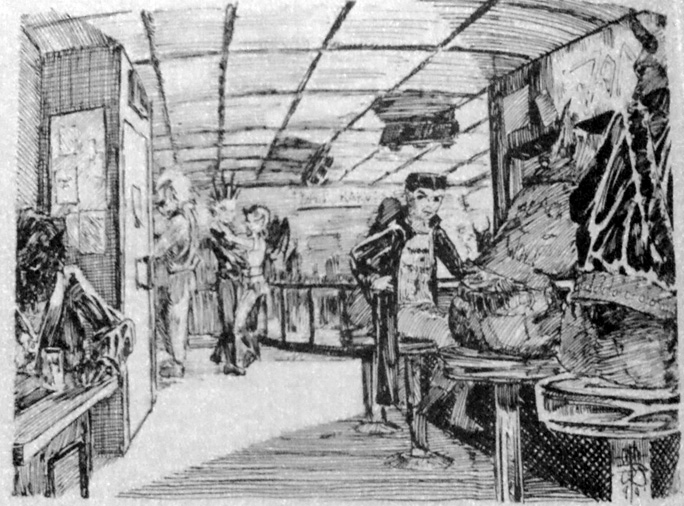
The interior of Club Afterdark - where various types of Kin (supernaturals) go to hang out
then cuts right into the intro fiction:
Nightlife posted:
Handbill posted in the Grand Central Station, New York City, NY, February 18, 1994:
Yea, my children, think and remember that as the Millenium approaches, and that Satan shall soon take his form to bring an ending to this world. Already does evil rule the world and inhuman things stalk abroad. Repent now, lest the last days find you side by side with the inhuman, and you be struck down to Perdition with them.
Anonymous graffiti beneath the handbill:
Bro, I'm NOT human and PROUD OF IT!
As you can see, it's set in the future! Party like it's 1994!

Fiction continues...
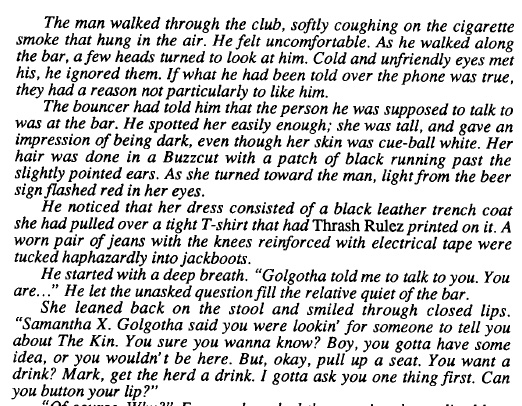
(Can't copy and past from the PDF and I'm lazy, sorry.)
Samantha X and the man talk a bit about music and how she'll kill him if he can't keep secrets. We also learn that Hardcore and Rap are the favoured music of the Kin (according to Samantha, anyway), and that Golgotha is the oldest Kin in the city.
Kin is a generic term for all supernatural types, whilst normal people are the Herd.
The fiction stops and we get an overview of the horror genre and how Dracula metamorphosed into the Lost Boys (and other gorier things). The theory proposed is that after the RL horrors of WWII, old style horror that cut away before showing you anything nasty happening just wasn't scary anymore - so boundries were pushed; we saw people getting ripped to bits rather than just the blood running down the street. It claims that Night of the Living Dead was the birth of the Splatterpunk sub-genre of horror.
I'm not particularly familiar with the horror genre, so I don't know how accurate or generally accepted a theory this is, but it sounds plausible enough.
The final part of the introduction is a brief overview of what sort of characters the players will usually be playing (One of several different sorts of supernaturals who are losely affiliated with the faction known as the Commune - Kin who're happy to share the planet with humans and generally just want to be left to get on with their own existance), followed by the standard paragraph on what an RPG is.
Next - character creation and the races of Kin.
Character Creation
Original SA post
Character creation and Kin, part 1
Characters in Nightlife have Abilities, Humanity, Edges, Flaws, Skills, a Personal Profile and Possessions. They can be Vampyres, Werewolves, Ghosts, Daemons, Wyghts, Inuits and Animates.
The Abilites are Strength, Dexterity, Fitness, Intellect, Will, Perception, Attractivness, Luck, Survival Points and base Hand-To-Hand damage. All except SP and HTH are rolled on 4d10, then modified by the chosen race of Kin.
Luck is used as a catch all for when the GM wants the players to roll against something but isn't sure what and can be used in place of skills that the character doesn't have, in which case the player rolls against Luck/5. The skill substitution is only allowed if the GM allows it, and the chance of sucess can never exceed 20% no matter how lucky the character becomes.
Let's make a character!
4d10=16, 4d10=19, 4d10=13, 4d10=20, 4d10=23, 4d10=19, 4d10=30, 4d10=24
I'll keep things traditional and make this character a Vampyre, modifying the Abilities to the following values.
Strength - 36
Dexterity - 24
Fitness - 18
Intellect - 20
Will - 23
Perception - 19
Attractivness - 35
Luck - 24
Survival points - 60 (Str+Luck)
HTH - 7 (STR/5 rounded to the nearest whole number)
Not too bad, espcially after Vampyre stat adjustments.
At this point you may be thinking that character creation is pretty quick. Don't worry - the Skills section will finish off that idea. It involves ALL the d10s.
Humanity
Serves the same purpose that it does in Vampire, but is rated on a 1-100 scale, and has both a permanent and temporary rating. Characters start with a Humanity of 50 and a Maximum Humanity of 100. Humanity is gained by being a generally decent chap and otherwise trying to keep interacting with humans (slightly oddly though you can gain humanity for killing in defence of another, and I don't think it's an error because you gain more for defending Herd than you do Kin. You also gain more for not killing even when it may be justified.)
Humanity is lost by being horrible or by activating your Edges (supernatural powers).
Max Humanity is adjusted at the end of the adventure where it can be either gained or lost depending on your current Humanity score - if Humanity is higher than max humanity, drop humanity by 10 and add one to Max, repeat until Humanity is less than Max H. If Humanity dropped below zero, add 10 and remove a point from Max humanity. Repeat until Humanity is above zero. Max humanity is also used to pay for new Edges (powers) above the default ones your Kin type gets, and to improve the rating of existing Edges.
The amount of damage you take from your Kin's vulnerabilities is adjusted by your current Humanity score, it can affect the appearance of the character and if Humanity reaches 100, you're functionally human - for instance, you don't need to feed, though the urge to feed builds up and will re-activate at full strength when humanity falls below 100.
The Kin
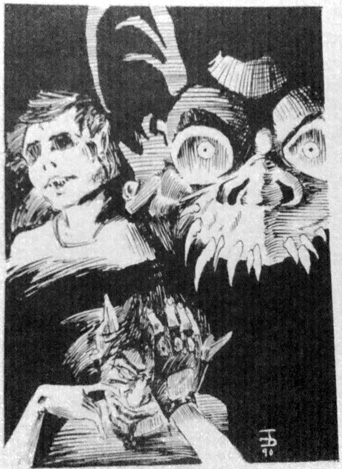
Vampyres. Not a sparkle or ankh to be seen
Here's their full statblock
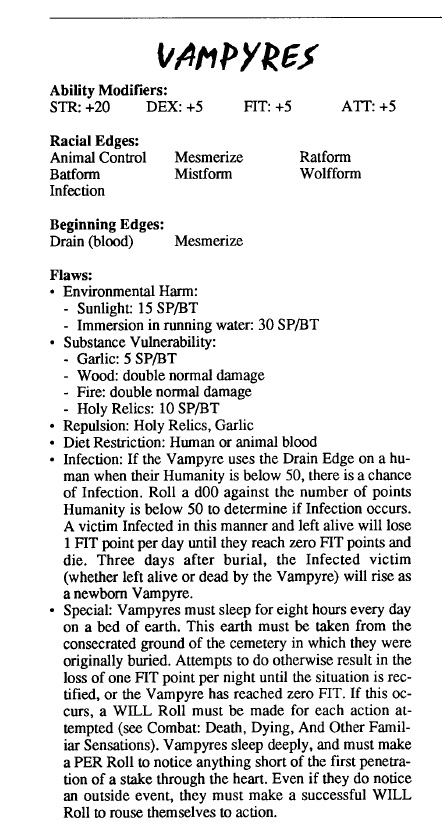
As you can see, they're pretty traditional compared to White Wolf's vampires who ditched most of the weaknesses and all that coffin and earth business.
The rest of the vampyre info covers the effect that their humanity score has - they look deader the lower it is, have a harder time staying in control when in the presence of food sources - and their feeding requirements - they need to drain 20SP of human or animal blood a night to avoid taking damage.
As well as their specific racial Edges, each type of Kin has automatic access to the following:
Armor, Aura Sight, Claws, Danger Sense, Drain, Event Manipulation, Locate Human, Mental Mapping, Nocturnal Vision, Photogenics (without this Edge, the Kin don't show up too well on camera), Send Dream, Speed, Time Sense, Weather Control.
All Kin are immune to Herd diseases but can suffer from something called Nerve Rot which turns them into an unthinking zombie. Additionally they're all unaging and only die after taking fatal damage a number of times equal to their FIT score.
The Lost Boys posted:
Sleep all day. Party all night. Never grow old. Never die. It's fun to be a vampire.
Which reminds me - Nightlife does the White Wolf thing of putting vaguely related quotations under their chapter headings. The one for the Kin section is "Of these immortal dead who live again." - George Elliot
------
Will finish character creation and cover the other races of kin tomorrow
Skills
Original SA post
Part 3 - Bring out the d10s - No, more d10s
or, Skills
To determine how many skill points you get, roll 20 d10s, and note down the results. Then assign the rolls to skills. You can't split an individual roll, but you can assign more than one roll to a skill.
Invisible Castle says posted:
7, 2, 2, 10, 1, 9, 5, 5, 1, 3, 10, 10, 1, 7, 9, 6, 1, 4, 1, 8
The skill list (located after the kin section) is pretty standard, being seperated into Combat, Unarmed combat, Archaic skills and General skills categories. The vast majourity of skills are under general skills.
Skills start at the level of their linked attribute, and a rating of 20 is considered competant - in a day-to-day enviroment you can use the skill without a roll. The game assumes that the GM will only be asking for skill rolls when the characters are either less than competent at the skill or they're under pressure.
So what wonderful skills can our characters learn?
Combat
Nothing terribly exciting here, just your usual shooting and stabbing people. Skills mostly run off Strength or Dexterity.
Unarmed combat
There are three skills in unarmed combat - Martial arts, Streetfighting (dirty tricks etc) and Wrestling. MA can be based off Str or Dex depending on whether you're using a Soft or Hard style. Streetfighting is based off Dex, and Wrestling off Str.
Each style has a few special maneuvers - e.g. Streetfighting's are Suckerpunch: A sharp blow to the kidneys may cause your opponent to miss their next turn; Low blow - a blow below the belt. May cause the opponent to take a +20 penalty to all combat skill rolls for the next 1d10 rounds; Throat Punch - as above except the penaly is +10, the duration is 2d10 rounds and it doesn't work on Undead kin as they don't need to breathe. (But you can still kick them in the goolies?
 )
)
Archaic skills
These are skills that have fallen out of common use, though may still be practised as hobbies.
Examples are Charioteering, Manuscript illumination and taxidermy. Also includes the odd useful thing like Ettiquette - Kin, the less useful Ettiquette - Court, and Knowledge - Kin.
General skills
Everything else. It has more or less any skill you could want for a character, and a few that you might not have realised you needed.
Ambidexterity is a skill - if you don't have it, or fail your Ambidexterity roll when trying to do things with your off-hand, that action takes a +25 penalty.
Bicycling too is a skill. And what 80s character would be seen dead without their Skateboard? And if you find yourself running a bit short of money, maybe you could earn some with an impromptu Mime performance. Or perhaps putting that Pharmacology skill to good use and cooking up some recreational chemicals of your own manufacture?
The final parts of character creation are the Personal profile - make up the fluff about your character, and... shopping for equipment!
Yes. Shopping for equipment. With a randomly determined amount of starting money no less. 1d10(1000)+3000 dollars, so between 4 13k.
The shopping list is just before the world section and starts with a long list of weapons before moving on to Ammo, some vehicles (which sound very expensive to me - 12k for a sports bike?), some musical instruments and then lots of clothes. Going by the prices, I assume that all Kin wear designer labels, or clothes have become a very precious commodity in the alt-1994 that this game takes place in. But don't worry, if you spent all your cash on guns and bikes and can no-longer afford a few t-shirts at $100 each, you can always get a Powder blue knit leisure suite for 3$.

Guns are cheaper than clothes. Spend all your money on guns, and a leisure suit, then mob someone better dressed for their frock. What could possibly go wrong.
There's some living expenses, and then technology.
Nightlife predicts minuturization. Your character can buy a palmtop computer. For $10,000. To be fair, the Psion series 3 didn't launch until 1991, and back in the early 90s, portable computers were more expensive than they are now compared to their desktop brethren.
To be fair to Nightlife, all this random generation and equipment list gubbins was pretty standard RPG design for the era.
That finishes up character creation. Join me next time when I'll be going over the rest of the Kin and some of their powers.
The Wyght Stuff
Original SA post
Part 4 - The wyght stuff
or, Kin
I think that the Kin section is ordered by how common each species is, because it's certainly not alphabetical.
We already covered Vampyres, so it's on to Werewolves .
Werewolves have three forms - Human, Werewolf and Wolf, each having different stat modifiers. They're vulnerable to Fire and Silver and are repulsed by Silver. They may accidentally shift forms when excited or annoyed (WILL roll to avoid, with bonuses for having a Humanity over 50), and unlike Vampires don't need to Drain to survive - they're perfectly happy with normal food, though are fond of red meat.
The NPC used in the explanation of the forced changing is called Shagman Doctor D.
Shagman Doctor D.

Ooooh... spooky. Ghosts are next.
Vulnerable to Cold Iron and Fire when corporeal and repulsed by Cold Iron, Ghosts also have the following flaws.
Exorcism - Can be done by someone who finds out the circumstatances of their deaths then performs and exorcism. The ghost gets an Escape Roll against WILL to avoid this.
What's an Escape Roll?

Wardrobe Restriction - Ghosts usually appear dressed in the style of the period in which they lived. A ghost may overcome this restriction for one night by making a successful Will roll. A new roll is required every night.
I like that it doesn't specify that they appear in the clothes that they died in, just that they have to match the period. The afterlife would be soo boring if one had to appear in the same blood-stained frock every night.
Relic - The ghost must spend at least 8 hours a day near a material object that was important to them in life. They take damage if they don't, and are destroyed if it is.
Their Humanity section explains the Exorcism Escape Roll

- It's just a WILL roll modified by Humanity.
My theory about the Kin section being in order of how common each type of kin is is ruined by the Ghost fluff which states they're the most common sort.
Daemons
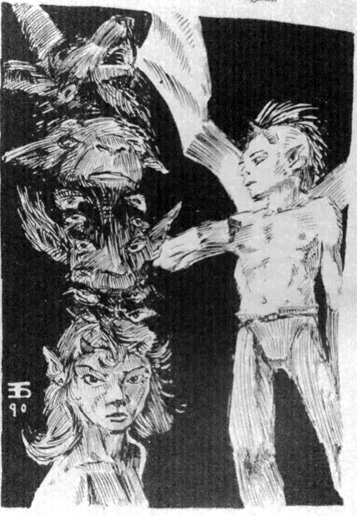
Sexy, right?
Well, that depends on their Humanity - as it lowers, their true form becomes more bestial; once Humanity is below 10 they have purple skin and look like goats. It doesn't go into detail where they came from or what they're doing on earth, just that they're from another plane and trapped here.
If their Humanity is below 50 they may not be able to shift out of their True Form. They need to feed by draining life force by touch, and prefer to hunt by using the Alter Form edge using persuasion or seduction rather than just jumping someone in an alleyway.
Now, the main attraction... it's
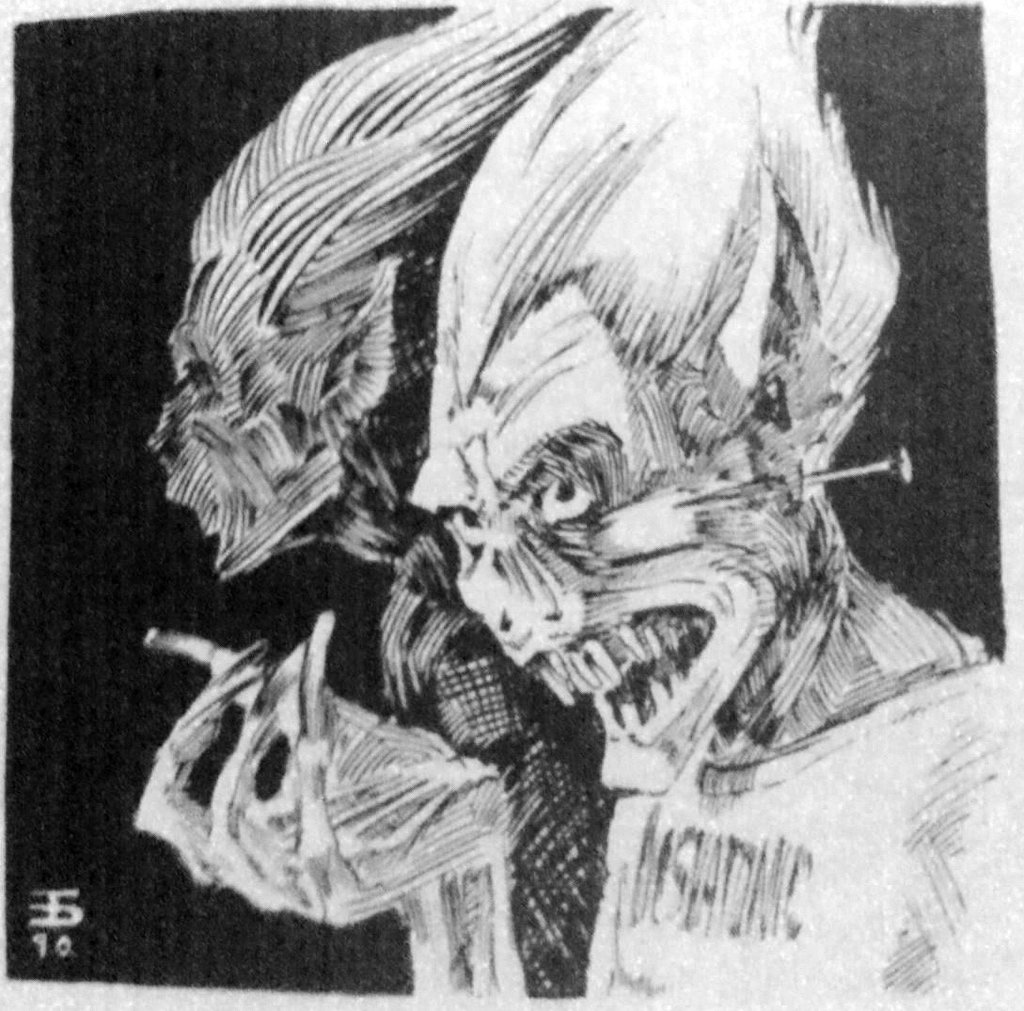
THE WYGHT STUFF!
Nyghtlyfe posted:
Some joker once said that wyghts are nothing but mummies without their Ace bandages. His friends later found him dead - strangled with an ace bandage.
Wyghts can't pass for human. Their skin is dried out and grey-ish, and their hair is shocking white and won't hold dyes.
Despite the nasty pointy teeth, and unlike the other Kin who feed off generic life force or blood, the Wyghts drain human or animal youth. For each SP that the wyght drains the victim appears to age a year. Their appearence will return to normal if they heal. This youth draining doesn't have any effect on the Wyght's appearance; they always look like dried up corpses.
Inuit
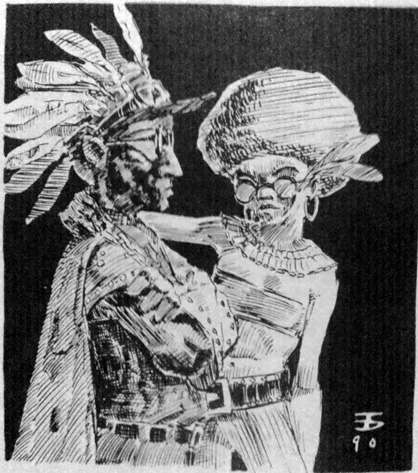
Masquerade? Keeping a low profile? Inuits care not for such things.
Inuits are American Indian spirits who used to haunt the western parts of North America up to Alaska, but have now migrated worldwide.
They're tied to an area of nature and have to visit it weekly, have a compulsion to be flamboyant, and they glow green when using any Edges. Fortunately, one of their Edges is Invisiblity.
They don't need to feed on anything special, but prefer unprocessed food. They do however have a compulsion to try and create new Inuits on the full moon, but this can be overcome with a Will roll.
Finally, Animates
These are the created monsters, though the game just offers options rather than setting the character's origin in stone. Some animates even manifested intelligence on their own rather than having been made by someone.
Animates don't have much interest in humanity, and the kin as a whole tends to side with the anti-human factions.
There's a list of types of animates, though they're all mechanically identical.
Flesh animates - Your basic Frankenstein's monster. Made of meat, and created by humans.
Golems/Stone spirits - Clay statues brought to life by Amerindian or Kaballic magic.
Homunculi - magical clones. The creator is probably still alive.
Animated dolls - Either sentient in their own right, or created by a spirit fused into the doll. Usually not more than three feet high.
Attack of the killer Barbies!
Living statues - It happens occaisionally that a sculptor creates a work perfect to the extent that the statue becomes a life form in its own right.
On a tangent, whilst you probably know about Pygmalion, there's a Hindu story of a sculptor who created a statue of Shiva Nataraj which was so perfect that it came to life and started dancing, beginning the destruction of the world. The statue was only stopped when the sculptor managed to break off one of its toes, thus marring its perfection.
Back to Animates - their section closes with a note that not all animates are humanoid, but the non-humanoid ones don't tend to last long as they have a hard time blending in to feed.
There's an interesting mix of races, and they're all usable as PCs. There's a potential for badwrong creepiness, but it's not hardwired into the system or the fluff.
Edges
Original SA postWell, that little Angrymog - Abandoned has shamed me into continuining Nightlife
The existing writeup is here
http://projects.inklesspen.com/fata...ymog/nightlife/

Section 3 - Edges
...There I found the will to power.
-- Nietzche
Edges are your supernatural powers. Each Kin (supernatural creature) has access to a set of generic ones - claws, the ability to be photographed, Locate Human, Weather Control and so on, and then some which are specific to their Kin type.
As we saw perviously, Vampyres get access to Animal Control, Batform, Infection, Mesmerize, Mistform, Ratform and Wolfform, with starting Vampyres having Drain (Blood) and Mesmerize already activated.
Edges are associated with an Attribute, and require a roll to activate. Using Edges against Kin who have a Humanity of less than 100 is much harder than using them against the Herd (normal people).
When an Edge is activated for the first time ever, you pay its Activation cost from your Maximum Humanity - A Vampyre turning into a bat for the first time ever will take a 4 point hit to Maximum humanity, and can increase their score in it by paying 1 Maximum humanity per five points. Turning into a bat once the edge has been activated costs 1 Humanity per use.
These are pretty fast bats - their flying speed is equal to the Edge rating in MPH, and starts with a Base of Will.
The Edges are your basic grab bag of supernatural features.
Alter Form
- allows you to look like a human - child or adult. Also allows changes of clothes, and production of accessories. If the roll is failed, there are things subtly wrong with the form that the power user can't see. Doesn't adjust attributes.
Animal Control
- must be bought for each type of animal. Edge score is maximum number of animals under cotnrol at any one time.
Animal Empathy
- make friends with animals
Armor
- Exactly what it says
Aura sight
- Tells you stuff about people (race, sex, healthiness, whether they're human or kin and whether they're under mind control)
Batform
- Turn into a bat. A fast bat.
Body Control
- The ability to reshape the body structure of a single victim according to the whims of the user. The user needs to fail a humanity roll to use this power, and must continue to fail the roll each combat turn to continue to use it. The cost to use is paid each turn.
If the roll is succeeded they Kin can't attempt to use Body Control against that intended victim until the situation changes.
Body control only affects the shape of the victim, not their mass or composition.
This is a pretty gruesome power, and the fiction snippet has a character called Tiger X turning a monstrous mugger into a pile of intestines and other gore.
Cause Madness
- Makes someone violently mad and doubles their strength score. Victim gets to try and break free once a day with an Int roll. Why not Will?
Claws
- Snickt!
Corporeality
- Ghosts can become solid
Crowd Control
- A crowd can be commanded to take one immediate simple action, and will keep doing it whilst the user concentrates. e.g. "Kill whomever comes in" wouldn't work unless someone entered the area immediately after the command, but "Kill each other" would because they could start at that moment. (example from the book)
Danger sense
- Spider sense
Domination
- Mind control. Victims may attempt to break free each time a new command is given.
Drain
- The feeding power. Score determines how many SP (Survival Points) you can drain a turn, and the Humanity cost is determined by whether the victim was willing or not and whether you left them alive or not. Kin with a Humanity of less than 50 they need to suceed at a Humanity roll or keep draining until the victim is dead.
Some types of Kin can cause the Herd to become addicted to being Drained; for this to happen they have to drain slowly - maximum of 1 SP per turn, and the target has to survive. If these conditions are met, the Kin has to succeed at an Edge roll, and the victim fail at a WILL roll. An addicted member of the herd counts as a willing victim for that sort of Kin.
Empathy
- Sense feelings
Event Manipulation
- This one is fun, and available to all Kin types.
The character can re-write recent events or affect future ones. The difficulty is adjusted by how many people will be afffected, and how removed chronologically the event is from the Now. It's easier to adjust events that haven't yet happened, than to rewrite the past.
The power is expensive to buy, difficult and expensive to use and can attract the attention of Elementals and Elder Kin, nevertheless, it has amazing potential for campaign fuckery from both the GM and player side; I can't think of anything except Wish-wrangling in D&D or Mage: the Ascension that could possible cause more table discussion, and it makes me regret not having ever played Night Life.
After the glorious insanity of Event Manipulation, we're back to more mundane powers.
Fear Projection
- Boo!
Fiery breath
- FWOOOSH!

Flight
- Fly at the same speed as the Bat form earlier. Daemons have to manifest their true form to use this.
Healing
- Heals wounds and cure diseases. Acts as the Regeneration power as the maximum it can heal is its score per turn.
Induce Heart Attack
- Just an attack that ignroes armor. Doesn't work if the victims FIT is higher than the users.
Infection
- Make another one of whatever you are. Humanity cost is dependent on whether the target wants to become a Kin. The victim has to fail a FIT roll for it to take.
Invisibility
- If the use roll is failed, the invisibility is flawed in some way.
Levitation
- Worse flight
Locate human
- Ability to place a psychic tracker on a specific human, not to detect humans in general
Lupine form
- Turn into a wolf. Turn into a wolf, pretty good stat boosts, and a chance to forget how to do human things whilst in wolf form. Low humanity characters need a roll to change back.
Lychanthropic form
- Classic werewolf form. Attribute modifiers not as good as the Lupine form, but you get to keep hands? Penalties on skill use, including combat skills, but you can use your Edge score in this or the Claws Edge without penalties.
Mental Mapping
- Know where north is
Mesmerize
- Weaker Domination, but victim will have no memory of having been Mesermized
Mist form
- Turn to fog. Fly around slowly.
Necropathy
- Speak to dead
Noctorunal vision
- See in the dark
Photogenics
- Allow yourself to show up on film
Possession
- Take over someone's body. Damage is applied to them first.
Rat form
- Squeek! Good at hiding and not being hit.
Reanimate dead
- Make zombies. They last for a number of days equal to half the edge score and can understand commans up to 10 words in length
Send Dream
- Enter and shape people's dreams. With a high enough Edge score and a low enough WILL score between the Kin and the victim, this can do real damage to them.
Another good mindfuck power; I'm guessing it's inspired by the Nightmare on Elm street films?
Sense Acuity
- I can see for miles and miles and miles
Speed
- Run really fast. Doesn't affect the speed of alternate forms.
Telekinesis
- Move stuff with your mind
Telepathy
- Speak stuff with your mind
Time sense
- For Kin who don't believe in watches. Also lets you know exactly how long it is until celestial events like Sunrise etc.
Touch of Ice
- Make people cold
Travel
- Teleport in line of sight
Weapons immunity
- immune to mundane weapons that do less damage than their edge score. An attack that does more damage than the edge score does its full damage.
Weather control
- Temperature changes, make it rain or hail, call lightning. Area is a circle with a diameter of the Edge rating in yards. Doesn't say that it has to be outdoors, and has a 25% chance of attracting Elemental attention.
Wolfform
Turn into a wolf.
And we're done with the Edge section. There's a couple of fun powers, and I can't think of anything obvious missing. Rules seem relatively unified in that the Edge score controls most aspects of a Power's effect.
Next time will be flaws and combat.
Flaws, Mechanics, and Combat
Original SA postThe existing writeup is here
http://projects.inklesspen.com/fata...ymog/nightlife/

Last post we looked at the edges. This time we're looking at the flaws, basic game system and combat.
Flaws aren't things like 'Bad Hairdo' or 'Angsty' like you might find in the WoD, but are linked to the Kin-type of the character. There's nothing particularly special amongst them, they just model the standard monster vulnerabilities such as being harmed by specific substances or enviromental effects, being disliked by animals, not beign able to go near certain symbols and so on.
Most of the flaws are ignorable with a successful WILL roll, which is made easier or harder based on how far above or below 50 the character's humanity is.
The Skills section is next in the book, but we already covered it in an earlier post. Like a lot of 80s and 90s games, the skill list is very detailed in its quantity of skills if not the amount of detail each one has. A level of 20 is considered competant in the skill - no roll is required for everyday use of it.
To use a Skill or an Edge, make a d100 roll and score below your rating. Rolls may be modified by the GM with a modifier range of -30 to +30 applied to the die roll.
Combat
Nightlife uses the 6 second turn, and characters may move 20 yards or Dex whichever is higher and may also use a Combat skill or Edge in the round.
Initiative is based on your score in your combat skill or edge - highest goes first, then people doing non-combat things rank their initiative in the same way.
Apart from that, Combat is your basic roll under your skill, total up your damage, remove effects of armor and apply damage.
There are actually two sorts of armor - the one provided by the Edge simply removes damage done, whereas worn armor adds to the difficulty of landing a blow based on the percentage of body covered - e.g. a flak vest covers 40% of the body, so attack rolls against a target wearing one take a 40% penalty.
There are special sections for Fighting on a Dancefloor - +25% penalty due to lighting, noise and people, and then the usual rules for blind fighting, aiming cover, falling and fire. Nothing really special here.
There's a Fear table - results range from mildly shaken to totally catatonic, and a section titled "Putting the Splatter back in Splatterpunk"
Someone once said that if something was worth doing, it was worth overdoing. Whoever said it had a good idea of what splatterpunk was going to be, because it's not a movement that deals well with restraint.
You couldn't really play Splatterpunk in a normal role-playing situation without an exhorbitant bodycount, but the near-immortality of the characters in Nightlife allows for a bit more leeway.
The rest of the quite short section is about how the amount of damage received equates to wound sizes, for instance an impaling attack will penetrate 2" for every 5 points of damage inflicted, whilst the wound by a slashing weapon will be 2" long for every 5 points of damage.
It seems a bit clinical - I think I'd just go for describing Fist of the North Star style blood sprays for big damage numbers rather than precise numbers.
There's rules for Nerve Rot, a disease which turns Kin into unthinking and depowered zombies. It is curable in all except the last stages by consuming vast amounts of whatever your Kin-type needs to feed on, but will destroy your skills and powers if not stopped fast.
In regards to death, all the Kin types return to life at the next sunset unless they're killed by their special method, though staking alone isn't enough to kill a vampire.
There's also a weapon table, but it's mostly boring, though does include Ice picks, Switchblades, Motorcycles chains and broken bottles, but oddly, no chainsaws.
Next post will be Slang and Fiction.